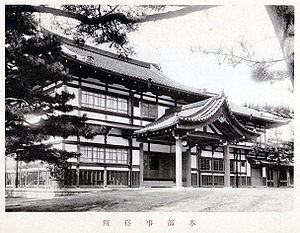- Dai Nippon Butoku Kai
-
 Butokuden in 1899
Butokuden in 1899
Dai Nippon Butoku Kai (DNBK) (Kyūjitai: 大日本武德會; Shinjitai: 大日本武徳会, lit. "Greater Japan Martial Virtue Society") is a Japanese martial arts organization established in 1895 in Kyoto, Japan, under the authority of the Ministry of Education and sanction of the Emperor Meiji.[1] Its purpose, at that time, was to standardize martial disciplines and systems throughout Japan.[2] This was the first official martial arts organization sanctioned by the government of Japan. It promoted the martial virtues of samurai warriors and high historical proficiency in martial disciplines.[3]
Contents
Meiji Era
During a time when foreign influence was viewed as a threat to Japanese identity, the Dai Nippon Butoku Kai was formed chiefly to perpetuate Japanese cultural traditions such as bugei and bushido.[4] To facilitate the continuation of these traditions, the Meiji Government permitted the group to perform the following:[5]
- Hold exhibitions and tournaments,
- collect weapons and equipment,
- maintain documents detailing classical combative arts, and
- publish martial-arts related material
Origins
Shindō jinen-ryū (神道自然流 Shindō jinen-ryū) is one of the six original karate schools, or ryū, recognized by the DNBK in the early 1930s. The system was founded by Yasuhiro Konishi, a practitioner of Shindo Yoshin-ryū Jujutsu who trained with many of the first Okinawans to teach karate in Japan. Konishi trained with Gichin Funakoshi (founder of Shotokan), Kenwa Mabuni (founder of Shitō-ryū), Chōjun Miyagi (co-founder of Gōjū-ryū), legendary fighter and teacher Motobu Chōki, and Morihei Ueshiba (founder of Aikido).[6][7]
Konishi's organization, Japan Karate-dō Ryobu-Kai, has spread worldwide, with branches in more than 20 countries under the leadership of Yasuhiro (Takehiro) Konishi, 10th dan, and the guidance of Kiyoshi Yamazaki, 8th dan, International Director and Chief Instructor. Shindō Jinen-ryū draws heavily from both Shotokan and Shitō-ryū but also extensively utilizes aikido, jujutsu, and kendo principles and techniques, reflecting the founder's background. Japan Karate-dō Ryobu-Kai is the only organization associated with the six original styles of karate that has never experienced an internal schism, and it remains the sole unifying body for Shindō Jinen-ryū Karate-dō.
Post-war
In 1946, after the end of World War II, the Supreme Commander of Allied Powers issued a directive to dissolve all military-related organizations, and the DNBK was broken up.[8] In 1952, the Kokusai Budoin (now the International Martial Arts Federation) was established in the same tradition as the DNBK. In 1953, the present DNBK was reestablished with a new charter and the new philosophical vision,[8] but not with an official assignment like in pre-World War II days. The DNBK aims to improve international understanding and world peace through promotion of martial arts training, education and service.
United States of America
The DNBK's Virginia (USA) division was founded in 1972, and subsequently the USA division was established in 1985. In 1992, the DNBK's International Division Headquarters was established in the USA.[3]
Martial disciplines
Disciplines which are officially approved and recognised by the Dai Nippon Butoku Kai include the following:
- Aikido
- Daitō-ryū Aiki-jūjutsu
- Jōjutsu
- Judo
- Jujutsu
- Karate
- Kendo
- Kosshijutsu
- Kyūjutsu
- Iaidō
- Okinawan kobudō
- Sōjutsu
See also
- International Martial Arts Federation
References
- ^ Patrick McCarthy; Yuriko McCarthy (1999). Ancient Okinawan Martial Arts. Boston, MA: Tuttle Publishing. pp. 73. ISBN 084831476 (Paperback). http://books.google.com/books?id=NK5CJKwQLsEC&pg=PA71&dq=%22Dai+Nippon+Butoku+Kai%22&hl=en&ei=Q2gsTreIA4GLsAK8t9GgCw&sa=X&oi=book_result&ct=result&resnum=3&ved=0CDUQ6AEwAg#v=onepage&q=%22Dai%20Nippon%20Butoku%20Kai%22&f=false. Retrieved 24 July 2011. "Founded during the Meiji Period...the Dai Nippon Butoku-kai was set up in the ancient captial of Kyoto in 1895."
- ^ All Japan Kendo Federation (February 1, 2000): Japanese-English Dictionary of Kendo (p. 46). Tokyo.
- ^ a b Dai Nippon Butoku Kai: Honbu, Kyoto, Japan (2010). Retrieved on January 1, 2011.
- ^ McCarthy 1999, p. 73
- ^ McCarthy 1999, p. 74
- ^ Howard High Shindo Jinen Ryu Retrieved on December 24, 2010.
- ^ Patrick McCarthy (2008) Ancient Okinawan Martial Arts: Koryu Uchinadi (pp. 42–43). Tuttle Publishing.
- ^ a b Dai Nippon Butoku Kai: HIstory and philosophy (2010). Retrieved on January 1, 2011.
External links
Categories:- Empire of Japan
- Japanese culture
- Japanese martial arts
- Organizations based in Japan
- Martial arts organizations
Wikimedia Foundation. 2010.
